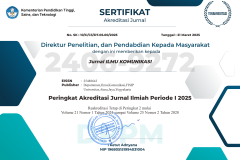Rancangan Model Promosi Kesehatan di Tempat Kerja Melalui Kampanye Public Relations
DOI:
https://doi.org/10.24002/jik.v19i1.3851Keywords:
promosi kesehatan di tempat kerja, kampanye public relations, staf pengajar, organisasi pendidikan tinggiAbstract
Staf pengajar organisasi pendidikan tinggi berpotensi mengalami stres dan kelelahan bekerja yang berdampak buruk terhadap kesehatan. Idealnya, organisasi pendidikan tinggi melakukan promosi kesehatan di tempat kerja melalui fungsi public relations. Penelitian ini menggunakan metode studi kasus. Hasil penelitian menunjukkan beban kerja yang cukup tinggi dan ambiguitas peran dapat memicu stres dan kelelahan pada staf pengajar. Staf public relations belum optimal dalam menjalankan fungsi promosi kesehatan di tempat kerja. Riset ini merekomendasikan model promosi kesehatan yang mencakup identifikasi permasalahan melalui riset, perencanaan, implementasi, dan evaluasi.
References
Abouserie, R. (1996). Stress , Coping Strategies and Job Satisfaction in University Academic Staff. Educational Psychology : An International Journal of Experimental Educational Psychology, 16(1), 49–56. https://doi.org/10.1080/0144341960160104
Becker, J. A. H., Halbesleben, J. R. B., & Dan O’Hair, H. (2005). Defensive Communication and Burnout in the Workplace: The Mediating Role of Leader–Member Exchange. Communication Research Reports, 22(2), 143–150. https://doi.org/10.1080/00036810500130653
Ben-zur, H., & Michael, K. (2008). Social Work in Health Care Burnout , Social Support , and Coping at Work Among Social Workers , Psychologists , and Nurses Burnout , Social Support , and Coping at Work Among Social Workers , Psychologists , and Nurses : The Role of Challenge / Control Ap, 1389. https://doi.org/10.1300/J010v45n04
Bertotti, M., Dan-ogosi, I. E., & Rao, M. (2016). Workplace well-being in the business community. https://doi.org/10.1108/IJWHM-05-2016-0035
Bevan, S. (2007). Workplace Health in the UK. American Journal of Health Promotion, 30(5), 396–398. https://doi.org/10.1177/0890117116647702b
Cutlip, S. M., Center, & Broom. (2007). Effective Public Relations (9th ed.). Jakarta: Kencana Prenada Media Group.
Dailey, S. L., & Zhu, Y. (2017). Communicating Health at Work : Organizational Wellness Programs as Identity Bridges. Health Communication, 32(3), 261–268. https://doi.org/10.1080/10410236.2015.1120698
Davenport, L. J., Allisey, A. F., Page, K. M., Lamontagne, A. D., &
Reavley, N. J. (2016). How can organisations help employees thrive ? The development of guidelines for promoting positive mental health at work, 9(4), 411–427. https://doi.org/10.1108/IJWHM-01-2016-0001
Dickson-swift, V., Fox, C., Marshall, K., Welch, N., & Willis, J. (2014). What really improves employee health and wellbeing Findings from regional Australian workplaces. https://doi.org/10.1108/IJWHM-10-2012-0026
Hall, J., Kay, T., Mcconnell, A. K., & Mansfield, L. (2019). Implementation of sit-stand desks as a workplace health initiative : stakeholder views, 12(5), 369–386. https://doi.org/10.1108/IJWHM-02-2019-0026
Hayu, S. (n.d.). “Burnout” Mengintai Pekerja Usia Produktif - Unair News. Retrieved February 22, 2020, from http://news.unair.ac.id/2017/10/16/burnout-mengintai-pekerja-usia-produktif/
Hodgins, M., Battel-kirk, B., & Asgeirsdottir, A. G. (2010). Building capacity in workplace health promotion : the case of the Healthy Together e-learning project. Global Health Promotion, 17(1), 60–68. https://doi.org/10.1177/1757975909356629
Howard, J. T., & Howard, K. J. (2020). The effect of perceived stress on absenteeism and presenteeism in public school teachers. Journal of Workplace Behavioral Health, 0(0), 1–17. https://doi.org/10.1080/15555240.2020.1724794
Jones, A. M., Koehoorn, M., & Jones, A. M. (2019). Work stress and recognition of need and intention to improve physical health to improve physical health. Journal of Workplace Behavioral Health, 33(3–4), 187–199. https://doi.org/10.1080/15555240.2018.1542309
Kim, H., & Lee, S. Y. (2009). Supervisory communication, burnout, and turnover intention among social workers in health care settings. Social Work in Health Care, 48(4), 364–385. https://doi.org/10.1080/00981380802598499
Miles, M. B., Huberman, A. M., & Saldana, J. (2014). Qualitative Data Analysis: A Methods Sourcebook (3rd ed.). Los Angeles, CA: SAGE Publications, Inc.
Miller, K. (2012). Organizational Communication: Approaches and Processes (6th ed.). Boston, MA: Wadsworth Cengage Learning.
Moore, A., Parahoo, K., & Fleming, P. (2011). Managers ’ understanding of small and medium-sized enterprises : Health Education Journal, 70(1), 92–101. https://doi.org/10.1177/0017896910364881
O’Donnell, M. P. (2002). Health Promotion in the Workplace - Google Books (3rd ed.). New York: Delmar Thomson Learning. Retrieved from https://books.google.co.id/books?id=KN3T5OEvOVsC&pg=PA92&dq=workplace+health+promotion+public+relations&hl=en&sa=X&ved=0ahUKEwjMnNHl6ZnoAhXOfn0KHSFfBr8Q6AEIKTAA#v=onepage&q=workplace health promotion public relations&f=false
Omilion-Hodges, L. M. (2014). Public Relations and Health Promotion. In T. Thompson (Ed.), Encyclopedia of Health Communication. SAGE Publications, Inc. https://doi.org/10.4135/9781483346427.n443
Seitel, F. P. (2016). Praktik Public Relations. Jakarta: Erlangga.
Tsai, R., Alterman, T., Grosch, J. W., & Luckhaupt, S. E. (2019). Availability of and Participation in Workplace Health Promotion Programs by Sociodemographic , Occupation , and Work Organization Characteristics in US Workers, 33(7), 1028–1038. https://doi.org/10.1177/0890117119844478
Zábrodská, K., Mudrák, J., Šolcová, I., Květon, P., Blatný, M., & Machovcová, K. (2018). Burnout among university faculty: the central role of work–family conflict. Educational Psychology, 38(6), 800–819. https://doi.org/10.1080/01443410.2017.1340590
Downloads
Published
How to Cite
Issue
Section
License
Copyright (c) 2022 Jurnal ILMU KOMUNIKASI

This work is licensed under a Creative Commons Attribution 4.0 International License.
Jurnal ILMU KOMUNIKASI is an academic journal. As such, it is dedicated to the open exchange of information. For this reason, JIK is freely available to individuals and institutions. Authors who publish in Jurnal ILMU KOMUNIKASI will release their articles under the Creative Commons Attribution (BY) License. This license allows anyone to copy and redistribute the article in any medium or format as well as remix, transform, and build upon the material for any purpose, even commercially as long as they credit the authors for the original creation. For details of the rights authors grants users of their work, see the "human-readable summary" of the license, with a link to the full license. (Note that "you" refers to a user, not an author, in the summary)
 This work is licensed under a Creative Commons Attribution 4.0 International License.
This work is licensed under a Creative Commons Attribution 4.0 International License.














